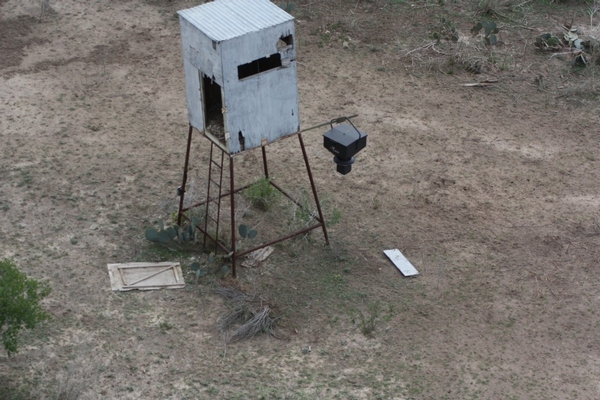
Deer Blind Location

Blind placement is one of the most overlooked segments of deer hunting I regularly encounter. When selecting a suitable location, don’t think like a human, but like that of a deer. Oftentimes, placing the blind for convenience is much different than placing it where it may offer the best chance for success. Deer, particularly mature bucks, use travel corridors — edges, drainages, creeks, tree lines and other screening covers to get from one place to the next. Outside of the rut and the accompanying brief lapse of intelligence, mature bucks stick close to these landscape features to offer maximum concealment as they travel. A well placed blind will be able to observe these corridors, perhaps more than one simultaneously, at a safe enough distance to avoid detection by the quarry yet offering a high percentage shot distance.
Placing the blind too close to travel or feeding locations such as feeders or food plots will disrupt the animal’s daily routine and minimize success significantly. Feeders should offer protective cover as animals travel to and from them as well. Feeders in the wide open offer no such protection and create deer activity only under the cover of darkness.
Obviously, prevailing wind direction must also be taken into consideration. Cross or down wind from travel and feeding areas will ensure the best chance of success and such locations must only be hunted when the winds are favorable. Hunting these locations when the winds are “not right” will only educate the animals and make them more wary of the area. Outside of the rut, most mature bucks will approach a feeding location downwind to scent-check the area for danger and for hot does before exposing themselves. If your blind is too close to the feeder, the buck will approach downwind of your location as well as the feeder and you will be busted. If your blind is too far, you may be unable to make an accurate shot. Since “how far is too far” is highly variable, try to take into account your actual abilities and place the blind at as far away from the feeder as you can confidently make the shot.
An often overlooked part of deer blinds is anchoring them to the ground. The winds are not always calm in Texas, so making sure your blind will be there next hunting season is a must. Tie-downs, anchors, guy wires, concrete posts and t-posts are required to not only keep your blind upright, they will also help keep the blind steady when the moment of truth arrives and you have to make the shot.
There is an unwritten rule among ethical hunters and landowners that states that no hunting blinds will be placed along property lines. The appropriate distance requires common sense based on topography, habitat, line-of-sight and shooting direction. The same holds true for feeder placement. No neighboring landowner should be able to see your feeders or blinds and you should not be able to see theirs. If your property is small and irregular shaped, hunt only the center and perhaps a tower blind is not for you. If your property is large, concentrate on travel corridors away from the boundary line and out of sight of the neighbors. Common sense and blind location not only makes hunting a safer and more enjoyable sport, but makes for much better neighbors as well.
Other helpful hints when selecting blind locations:
- Sunrise and sunset facing blinds are obviously limiting, so place blinds to look north or south or realize hunting such sun-facing locations may only be hunted when the sun is at your back (and the wind is right).
- Take into account human traffic such as highways, walking/hiking trails, fishing areas, farmhouses and other high-use areas that may be dangerous to shoot towards. Deer may or may not be scared of these areas, but hunters must be cognizant of the bullet’s flight path at all times.
- How will you access your hunting blind? Walking past the feeder or through the food plot is not wise. You need to enter the blind into the wind and with the least amount of disturbance as possible.
- Placing the blind below the crest of the hill, not on top, will keep you from being silhouetted while traveling to and from the blind.
- Sit in the back or corner of the blind and do not allow yourself to be silhouetted against the sky behind you. Sit in front of the latched door, use dark curtains, or completely cover the window behind you.
- Use comfortable seats that are the correct height to shoot out of the windows.
- Staying quiet and still only increases your chances of success.
- The windows should be only tall enough to get your scoped rifle easily through without banging the frame. Large windows allow for your movement to be seen from the outside and allows for more scent to escape.
- Make the blinds large enough to safely and comfortable hold all the hunters and their gear. If youth or guiding hunters are planned, bigger is always better. Cramped quarters create more noise and less comfort.
Posted in: Land Management
